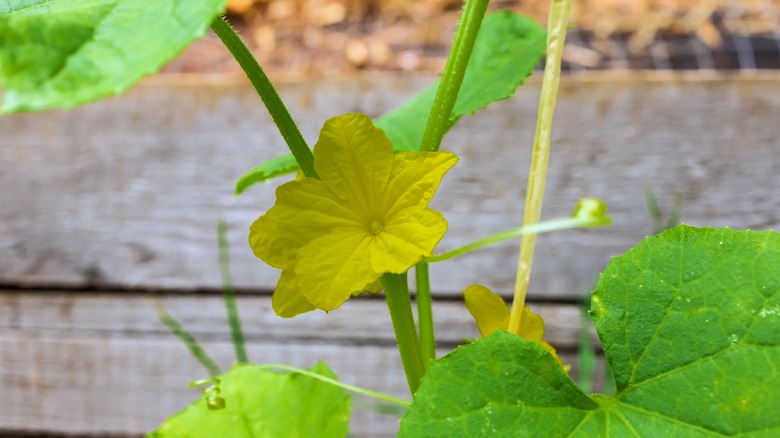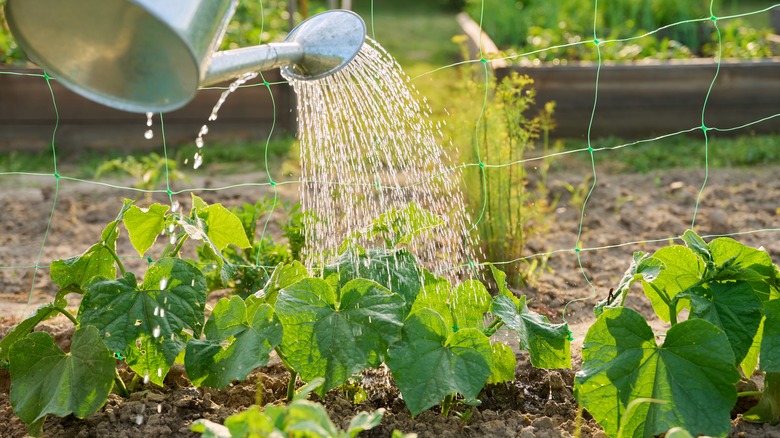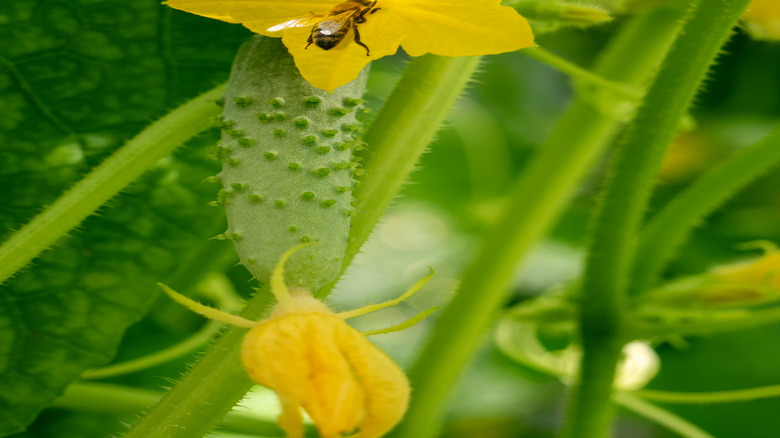The Reasons Your Cucumber Plant Is Only Flowering & Not Producing (And What To Do)
As sweet as it is to spot yellow flowers popping up on a cucumber (Cucumis sativa) plant, when you're trying to create a flourishing vegetable garden, it's upsetting when you only see flowers and they aren't producing anything edible. You may notice flowers but no cucumbers if the plant has the wrong ratio of male to female flowers, if there aren't enough insects to pollinate the flowers, or as a result of pesticide use. However, there are some steps you can take to get fruit production going. If all else fails, hand-pollinating the flowers might be necessary.
Looking at the plant can help you diagnose whether an imbalance of flowers is the problem. Male and female cucumber flowers appear on the same plant but look different. The male flowers will usually open before the female flowers during the blooming season, which runs from July through September. Cucumbers — technically a fruit — grow from the flowers after bees or other pollinating insects spread pollen from the male flowers to the female ones. It's normal to see only male flowers at the start of this season, and the first batch of them will fall off the plant, but something may be off if it's been more than a few weeks. After that period, check to make sure there are a good number of female flowers, which will have a visible ovary: a swelling at the base that looks like a tiny cucumber.
Factors that prevent cucumber plants from producing
If you're waiting too long for cucumbers to develop, a number of factors may be to blame. Even though the plant can grow well in all regions of the U.S., it can get easily stressed by drought, which affects the ratio of male to female flowers it needs to make enough fruit. And when the plants receive either too little or too much water, they might abort their flowers and fruit, keeping a successful crop just out of reach. Generally, cucumber plants need 1 inch of water every week in the growing season, and they respond well to soil that contains lots of compost to help it stay moist.
There's also a reason cucumber farmers traditionally keep hives of bees within flying distance of the plants: a lack of enough bees or other pollinators in the garden can have a big impact on production, since insects carrying pollen from one flower to another is the way cucumbers develop in nature. Weather that's too cloudy, rainy, or chilly can keep pollinators like bees and butterflies away. Finally, some of the pesticides used to control cucumber beetles can harm pollinators when they come into contact with the chemicals in the plant's pollen and nectar.
How to get a cucumber plant to produce
Don't despair if you're concerned about your cucumber harvest; there are several ways to encourage production. For one, offer consistent and thorough waterings, especially during the season when the plants grow fruit. Giving them enough water can also help save your cucumbers from curling as an added bonus. When it comes to pollinators, adding other plants nearby that attract them could do the trick. Try placing potted bee-attracting herbs like basil, lavender, and oregano close by. Planting zinnias alongside the cucumbers is also a way to get a bee magnet within range.
If you're in an area where few wild bees live, and you notice both types of flowers on the cucumber plant, hand-pollinating may be the best option. Take a small paintbrush and use it to gather the yellow pollen in the middle of a male flower, then apply it to the female bloom. It's important to make sure both flowers are newly opened, making the morning an ideal time to hand-pollinate. Another way to give cucumber flowers the best chance of being pollinated is to stop the use of pesticides in the garden unless it's unavoidable.
Other changes may take a while to yield results, but can make cucumbers more plentiful in the long run. Plant a variety of flowers that attract pollinators so that they're more likely to be around in different weather conditions and toward the end of the cucumber plant's growing season, when it produces fewer flowers. It might also be worth planting a cucumber variety that produces only female flowers nearby. These cultivars tend to yield more fruit.


